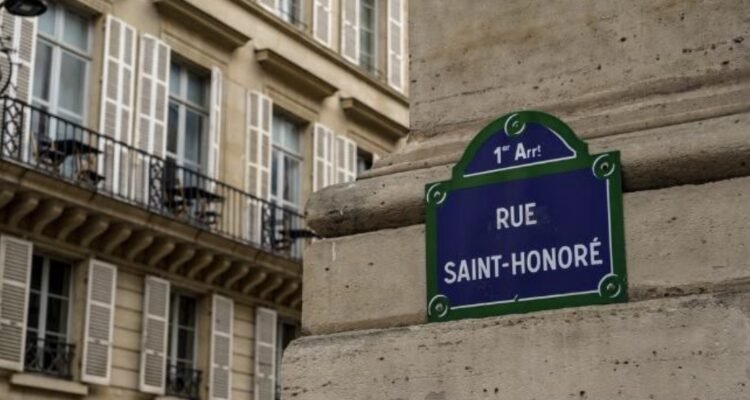Curious Corners: The Origins of Paris’s Street Names
Because even the cobblestones have stories.
Paris isn’t just a city—it’s a palimpsest, rewritten in layers over centuries of revolution, poetry, scandal, and glory. Its street names are more than coordinates; they’re fragments of gossip, reverence, and rebellion carved into plaques and mounted on stone. Some honor kings and saints, others nod to professions long extinct or taverns that once brimmed with debauchery. You’ve walked these streets—but have you ever read them?
The Socialites take you on a promenade through the poetic, provocative, and downright peculiar origins of Paris’s rues.
Rue du Chat-qui-Pêche (5e) — The Cat Who Fished
Paris’s narrowest street—just 1.80 meters wide—is also one of its most whimsical. Its name translates to “Street of the Fishing Cat,” allegedly inspired by a sign that once hung above a long-gone tavern. Some say it referenced a cat owned by an alchemist who was seen catching fish from the Seine. Others whisper it was code for something more… illicit.
Find it: Between Rue de la Huchette and Quai Saint-Michel
Rue de la Vieille-Lanterne (4e) — The Old Lantern
This hidden passage near Hôtel de Ville has a melancholic aura, and with good reason—it was once the site of gallows and public executions. The “lantern” may have been a hanging lamp or the gibbet itself. It’s also the supposed spot where poet Gérard de Nerval hanged himself in 1855. Today, it’s a peaceful path through history’s darker shadows.
Find it: Near Rue de Rivoli, discreet and easy to miss
Rue des Rosiers (4e) — The Street of Rosebushes
Today it’s a bustling artery of the Jewish quarter, known for falafel and fashion. But its name recalls a time when the Marais was still mostly gardens and countryside, filled with wild rosebushes that lined the path before the city walls pressed in.
Find it: Heart of the Marais, 4e arrondissement
Rue des Francs-Bourgeois (3e/4e) — The Free Citizens
“Francs-bourgeois” were middle-class Parisians exempt from certain taxes—yes, even tax history can sound elegant in French. This street once housed the city’s early bourgeoisie, and today it reflects that genteel charm with 17th-century mansions and upscale boutiques. The name is a soft echo of the power shift from nobility to citizenry.
Find it: Running from Rue Rambuteau to Rue des Archives
Rue du Faubourg-Saint-Denis (10e) — The Suburb Before the Boom
A “faubourg” was a suburb before it was swallowed by the city. This street once led out of medieval Paris toward the abbey of Saint-Denis. Over centuries, it’s morphed into a chaotic, multicultural stretch brimming with textile shops, Indian grocers, and hidden bars. The name is a reminder of its once-rural beginnings.
Find it: Between Porte Saint-Denis and Gare du Nord
Rue des Mauvais Garçons (4e) — The Bad Boys
Yes, it’s real. This Marais street was once known for its unruly residents—possibly former bodyguards or mercenaries turned voyous after too much wine and too few wars. Today, it’s tamer but keeps the edge in its name.
Find it: Parallel to Rue de Rivoli, just steps from Hôtel de Ville
Rue du Jour (1er) — The Street of Daylight
A serene name with cloistered roots. This street ran alongside the old Saint-Eustache convent, where nuns could walk during their one permitted outdoor hour—“the hour of the day.” It’s a poetic name for what was once a rare sliver of freedom.
Find it: Off Rue Montorgueil, near Église Saint-Eustache
Rue des Martyrs (9e/18e) — The Pilgrim’s Path
Named for Saint Denis, the first bishop of Paris who was decapitated on Montmartre’s hill. Legend says he picked up his head and walked this path, preaching as he went. Today, it’s one of Paris’s most charming streets—lined with fromageries, florists, and grocers—and still vibrates with quiet reverence.
Find it: From Notre-Dame-de-Lorette up toward Sacré-Cœur
Rue du Temple (3e) — Echoes of the Knights Templar
Once home to the imposing fortress of the Knights Templar, this street now cuts through the upper Marais. After the Order fell out of royal favor, the area slowly transformed—but the name stuck, and so did the mystique. Even today, some doors feel like they lead to secrets.
Find it: Running north-south from Rue de Rivoli into the 3rd
Rue Saint-Blaise (20e) — The Last Village
In a corner of Paris that still feels provincial, Rue Saint-Blaise winds like a village lane. The name honors the local church and its patron saint of throat ailments. It’s one of the last places in Paris where you can feel the rural origins of the city beneath your feet.
Find it: Near Place Saint-Blaise, in the heart of Charonne
Because in Paris, street names aren’t just labels—they’re lore.
A walk down Rue des Martyrs is a pilgrimage. A drink on Rue des Mauvais Garçons is a wink to rebellion. Every quartier, every plaque, every odd name holds a tiny window into the past.
So next time you wander, look up. Read. Let the city tell you who it’s been.
—The Socialites


